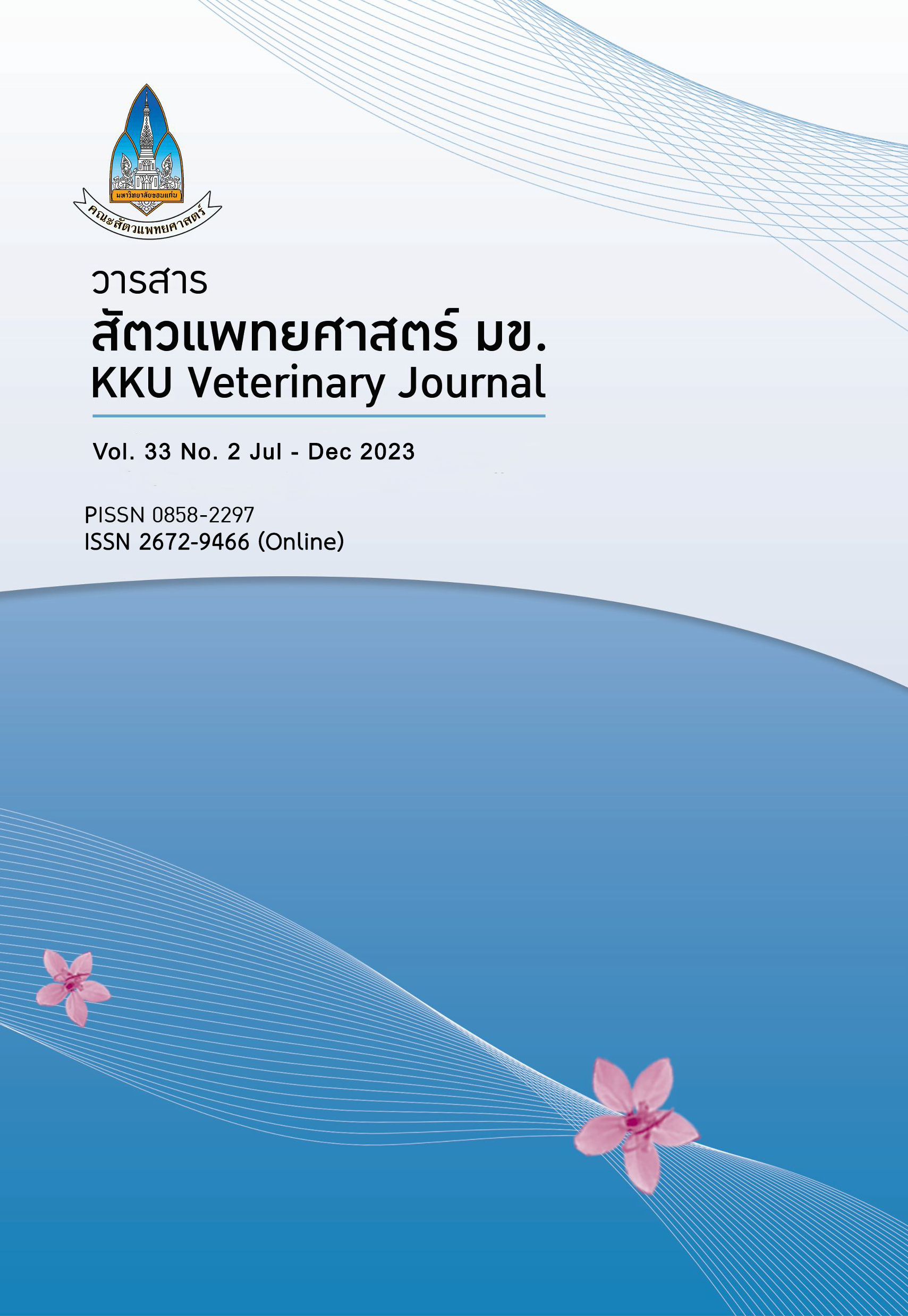Anthelminthic drug efficacy evaluation Ivermectin double dose, Ivermectin with clorsulon and Levamisole in Alpine Goats
Main Article Content
Abstract
Objective: This study was to evaluate the efficacy of anthelminthics (Ivermectin double shot, Ivermectin with Clorsulon and Levamisole) in Alpine goats by field trial study.
Materials and Methods: At Pattani Livestock Research and Breed Centre, 40 goats were grouped and separated into 4 treatments by different drugs (No treatment/Control, Ivermectin 0.2 mg/kg, Ivermectin with Clorsulon 0.2 mg/kg and Levamisole 8 mg/kg) in subcutaneous route on day 0 except Ivermectin group was given 2 shots on day 0 and 3 of the experiment. Fecal sampling was performed individually on day 0, 3, 7, 14, 21 and 28 of the study for count egg worms to estimate amount of egg worms in 1 gram of feces (Egg count per Gram; EPG unit) via McMaster technique. The amount of egg reduction was calculated in percentage in each period. Fecal egg count reduction (FECR) was utilized for the efficacy and resistance level in each group.
Results: The results found strongyle and strongyloides egg worms type, and the average egg amount before treatment were 1,460 (200-3,900) EPG with no difference between groups. After Day 3, egg count was significantly reduced in treatment groups (average egg amount 923, range 50-2,700) compared with the control group. In levamisole treatment group presented an average EPG amount was 10 (0-50), that was lowest and significantly decreased (P<0.01) when compared between groups and the maximum of FECR was 99.38 on day 14. In Ivermectin with Clorsulon group shows an average EPG amount in the period was 75(0-200), the maximum FECR was 92.10 on day 21. In Ivermectin double shot group presented an average EPG amount was 700(100-1,700) and the maximum FECR was 35.7.
Conclusion: FECR in each group indicates anthelmintics resistance and efficacy, Levamisole was a highly effective to control parasites in the gastrointestinal tract of goats. Ivermectin and Ivermectin with clorsuron group showed resistance anthelminthics except Levamisole. Therefore, Levamisole is a highly effective in controlling parasites in goats' gastrointestinal tract.
Article Details

This work is licensed under a Creative Commons Attribution-NonCommercial-NoDerivatives 4.0 International License.
References
Abongwa M, Martin RJ, Robertson AP, 2017. A brief review on the mode of action of antinematodal drugs. Acta Vet 67, 137-152.
Adediran OA, Uwalaka EC, 2015. Effectiveness evaluation of levamisole, albendazole, ivermectin, and Vernonia amygdalina in West African dwarf goats. J Parasitol Res 2015.
Aktaruzzaman M, Islam M, Hasan M, Bhuiyan M, Hossain M, Hossain M, Lucky N, Howlader M, 2015. Evaluation of anthelmintic efficacy of ivermectin, levamisole HCL and albendazole administered through different routes against naturally occuring gastrointestinal nematodiasis in Black Bengal Goat inducing hematological parameters and live weight indices. Int J Nat Sci 5, 26-34.
Arsenopoulos KV, Fthenakis GC, Katsarou EI, Papadopoulos E, 2021. Haemonchosis: A challenging parasitic infection of sheep and goats. Animals 11, 363.
Barger I, Siale K, Banks D, Le Jambre L, 1994. Rotational grazing for control of gastrointestinal nematodes of goats in a wet tropical environment. Vet Parasitol 53, 109-116.
Bosco A, Kießler J, Amadesi A, Varady M, Hinney B, Ianniello D, Maurelli MP, Cringoli G, Rinaldi L, 2020. The threat of reduced efficacy of anthelmintics against gastrointestinal nematodes in sheep from an area considered anthelmintic resistance-free. Parasit Vectors 13, 1-12.
Chaisanabunthid Vanni CS, Lawson Buripakdi Darunee , Kengkoom Kanchana , Ratanasak Wantanee, 2003. Effect of an injectable levamisole in elimination of gastrointestinal nematodes of sheeps. Proceeding of 41th Kasetsart University Annual Conference: :Animal husbandry and Veterinarians, 697-704.
Coles G, Bauer C, Borgsteede F, Geerts S, Klei T, Taylor M, Waller P, 1992. World Association for the Advancement of Veterinary Parasitology (WAAVP) methods for the detection of anthelmintic resistance in nematodes of veterinary importance. Vet Parasitol 44, 35-44.
De S, Sanyal P, 2009. Biological control of helminth parasites by predatory fungi. Vet Scan 4, 387-395.
Falzon L, Menzies P, Shakya K, Jones-Bitton A, Vanleeuwen J, Avula J, Stewart H, Jansen J, Taylor M, Learmount J, 2013. Anthelmintic resistance in sheep flocks in Ontario, Canada. Vet Parasitol 193, 150-162.
Glover M, Clarke C, Nabb L, Schmidt J, 2017. Anthelmintic efficacy on sheep farms in south-west England. Vet Rec 180, 378.
Inaam EA, El Tayeb IB, Sania AS, Hassan T, 2007. The effect of Haemonchus contortus infection and treatment with ivermectin on drug-metabolizing enzymes. Res J Anim Vet Sci 2, 66-71.
Kearney P, Murray P, Hoy J, Hohenhaus M, Kotze A, 2016. The ‘Toolbox’of strategies for managing Haemonchus contortus in goats: what’s in and what’s out. Vet Parasitol 220, 93-107.
Kumar Jaiswal A, Sudan V, Shanker D, Kumar P, 2013. Emergence of ivermectin resistance in gastrointestinal nematodes of goats in a semi-organized farm of Mathura district-India. Veterinarski arhiv 83, 275-280.
Limcharoen S, Khongsen M, Taaha S, Peeyao M, 2018. Effects of laveamisol Ivermectin and Albendazole on eradication of gastro-intestinal parasite in goats (Capra hircus). Khon kaen AGR J 46 SUPPL.1, 622-627.
Mitchaothai J, Lukkananukool A, 2021. Effectiveness evaluation of anthelminthics (Albendazole, Ivermectin and Levamisole) in a breeding stock sheep farm. J Mahanakorn Vet Med 16, 235-245.
Nabukenya I, Rubaire-Akiiki C, Olila D, Muhangi D, Höglund J, 2014. Anthelmintic resistance in gastrointestinal nematodes in goats and evaluation of FAMACHA diagnostic marker in Uganda. Vet parasitol 205, 666-675.
Paduang S, Thongtha R, 2020. Study of anthelmintic resistance of gastrointestinal nematodes in goats in Ratchaburi province. J Kasetsart Vet 30(1), 1-10.
Paraud C, Pors I, Rehby L, Chartier C, 2010. Absence of ivermectin resistance in a survey on dairy goat nematodes in France. Parasitol Res 106, 1475-1479.
Pipathsakulpak M, Pongthaisong P, 2018. Epidemiology and risk factor of gastrointestinal anthelmintic resistance in goat. KKU Vet J 30, 33-41.
Sangster NC, Cowling A, Woodgate RG, 2018. Ten events that defined anthelmintic resistance research. Trends Parasitol 34, 553-563.
Sloss MW,1970. Veterinary Clinical Parasitology: By Margaret W. Sloss. Iowa State University Press.
Vadlejch J, Petrtýl M, Zaichenko I, Čadková Z, Jankovská I, Langrová I, Moravec M, 2011. Which McMaster egg counting technique is the most reliable? Parasitol Res 109, 1387-1394.

